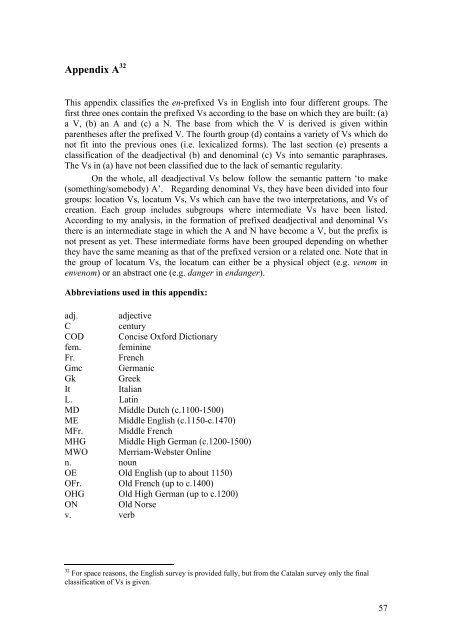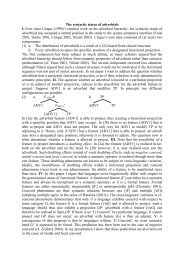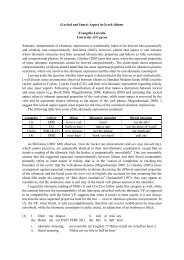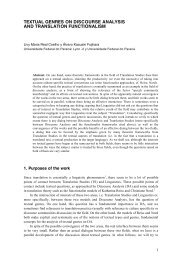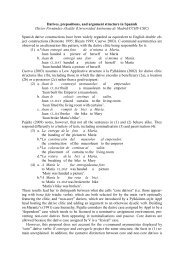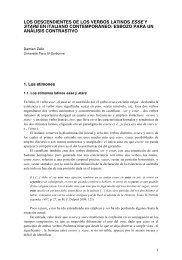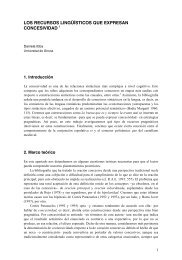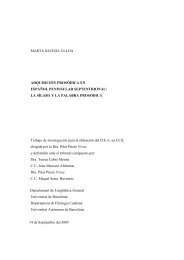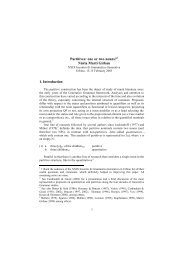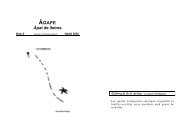Prefixation in English and Catalan - Departament de Filologia ...
Prefixation in English and Catalan - Departament de Filologia ...
Prefixation in English and Catalan - Departament de Filologia ...
You also want an ePaper? Increase the reach of your titles
YUMPU automatically turns print PDFs into web optimized ePapers that Google loves.
Appendix A 32<br />
This appendix classifies the en-prefixed Vs <strong>in</strong> <strong>English</strong> <strong>in</strong>to four different groups. The<br />
first three ones conta<strong>in</strong> the prefixed Vs accord<strong>in</strong>g to the base on which they are built: (a)<br />
a V, (b) an A <strong>and</strong> (c) a N. The base from which the V is <strong>de</strong>rived is given with<strong>in</strong><br />
parentheses after the prefixed V. The fourth group (d) conta<strong>in</strong>s a variety of Vs which do<br />
not fit <strong>in</strong>to the previous ones (i.e. lexicalized forms). The last section (e) presents a<br />
classification of the <strong>de</strong>adjectival (b) <strong>and</strong> <strong>de</strong>nom<strong>in</strong>al (c) Vs <strong>in</strong>to semantic paraphrases.<br />
The Vs <strong>in</strong> (a) have not been classified due to the lack of semantic regularity.<br />
On the whole, all <strong>de</strong>adjectival Vs below follow the semantic pattern ‘to make<br />
(someth<strong>in</strong>g/somebody) A’. Regard<strong>in</strong>g <strong>de</strong>nom<strong>in</strong>al Vs, they have been divi<strong>de</strong>d <strong>in</strong>to four<br />
groups: location Vs, locatum Vs, Vs which can have the two <strong>in</strong>terpretations, <strong>and</strong> Vs of<br />
creation. Each group <strong>in</strong>clu<strong>de</strong>s subgroups where <strong>in</strong>termediate Vs have been listed.<br />
Accord<strong>in</strong>g to my analysis, <strong>in</strong> the formation of prefixed <strong>de</strong>adjectival <strong>and</strong> <strong>de</strong>nom<strong>in</strong>al Vs<br />
there is an <strong>in</strong>termediate stage <strong>in</strong> which the A <strong>and</strong> N have become a V, but the prefix is<br />
not present as yet. These <strong>in</strong>termediate forms have been grouped <strong>de</strong>pend<strong>in</strong>g on whether<br />
they have the same mean<strong>in</strong>g as that of the prefixed version or a related one. Note that <strong>in</strong><br />
the group of locatum Vs, the locatum can either be a physical object (e.g. venom <strong>in</strong><br />
envenom) or an abstract one (e.g. danger <strong>in</strong> endanger).<br />
Abbreviations used <strong>in</strong> this appendix:<br />
adj. adjective<br />
C century<br />
COD Concise Oxford Dictionary<br />
fem. fem<strong>in</strong><strong>in</strong>e<br />
Fr. French<br />
Gmc Germanic<br />
Gk Greek<br />
It Italian<br />
L. Lat<strong>in</strong><br />
MD Middle Dutch (c.1100-1500)<br />
ME Middle <strong>English</strong> (c.1150-c.1470)<br />
MFr. Middle French<br />
MHG Middle High German (c.1200-1500)<br />
MWO Merriam-Webster Onl<strong>in</strong>e<br />
n. noun<br />
OE Old <strong>English</strong> (up to about 1150)<br />
OFr. Old French (up to c.1400)<br />
OHG Old High German (up to c.1200)<br />
ON Old Norse<br />
v. verb<br />
32<br />
For space reasons, the <strong>English</strong> survey is provi<strong>de</strong>d fully, but from the <strong>Catalan</strong> survey only the f<strong>in</strong>al<br />
classification of Vs is given.<br />
57


